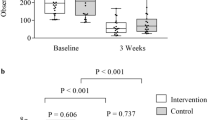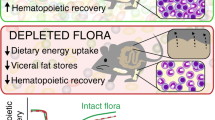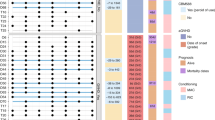Abstract
Advances in biological techniques have potentiated great progresses in understanding the interaction between human beings and the ∼10 to 100 trillion microbes living in their gastrointestinal tract: gut microbiota (GM). In this review, we describe recent emerging data on the role of GM in hematopoietic stem cell transplantation, with a focus on immunomodulatory properties in the immune system recovery and the impact in the development of the main complications, as GvHD and infections.
This is a preview of subscription content, access via your institution
Access options
Subscribe to this journal
Receive 12 print issues and online access
$259.00 per year
only $21.58 per issue
Buy this article
- Purchase on Springer Link
- Instant access to full article PDF
Prices may be subject to local taxes which are calculated during checkout

Similar content being viewed by others
References
Eckburg PB, Bik EM, Bernstein CN, Purdom E, Dethlefsen L, Sargent M et al. Diversity of the human intestinal microbial flora. Science 2005; 308: 1635–1638.
Dethlefsen L, Huse S, Sogin ML, Relman DA . The pervasive effects of an antibiotic on the human gut microbiota, as revealed by deep 16 S rRNA sequencing. PLoS Biol 2008; 6: e280.
Liu Z, Lozupone C, Hamady M, Bushman FD, Knight R . Short pyrosequencing reads suffice for accurate microbial community analysis. Nucleic Acids Res 2007; 35: e120.
Khosravi A, Yáñez A, Price JG, Chow A, Merad M, Goodridge HS et al. Gut microbiota promote hematopoiesis to control bacterial infection. Cell Host Microbe 2014; 15: 374–381.
Gill SR, Pop M, Deboy RT, Eckburg PB, Turnbaugh PJ, Samuel BS et al. Metagenomic analysis of the human distal gut microbiome. Science 2006; 312: 1355–1359.
Lee YK, Mazmanian SK . Has the microbiota played a critical role in the evolution of the adaptive immune system? Science 2010; 330: 1768–1773.
Candela M, Turroni S, Biagi E, Carbonero F, Rampelli S, Fiorentini C et al. Inflammation and colorectal cancer, when microbiota-host mutualism breaks. World J Gastroenterol 2014; 20: 908–922.
Goodman AL, Kallstrom G, Faith JJ, Reyes A, Moore A, Dantas G et al. Extensive personal human gut microbiota culture collections characterized and manipulated in gnotobiotic mice. Proc Natl Acad Sci USA 2011; 108: 6252–6257.
Goodrich JK, Waters JL, Poole AC, Sutter JL, Koren O, Blekhman R et al. Human genetics shape the gut microbiome. Cell 2014; 159: 789–799.
Caporaso JG, Kuczynski J, Stombaugh J, Bittinger K, Bushman FD, Costello EK et al. QIIME allows analysis of high-throughput community sequencing data. Nat Methods 2010; 7: 335–336.
Caporaso JG, Lauber CL, Walters WA, Berg-Lyons D, Huntley J, Fierer N et al. Ultra-high-throughput microbial community analysis on the Illumina HiSeq and MiSeq platforms. ISME J 2012; 6: 1621–1624.
Candela M, Biagi E, Maccaferri S, Turroni S, Brigidi P . Intestinal microbiota is a plastic factor responding to environmental changes. Trends Microbiol 2012; 20: 385–391.
Turnbaugh PJ, Ley RE, Hamady M, Fraser-Liggett CM, Knight R, Gordon JI . The human microbiome project. Nature 2007; 449: 804–810.
Wixon J, Kell D . The Kyoto Encyclopedia of Genes and Genomes—KEGG. Yeast 2000; 17: 48–55.
Liu J, Wang H, Yang H, Zhang Y, Wang J, Zhao F et al. Composition-based classification of short metagenomic sequences elucidates the landscapes of taxonomic and functional enrichment of microorganisms. Nucleic Acids Res 2013; 41: e3.
Davenport CF, Tümmler B . Advances in computational analysis of metagenome sequences. Environ Microbiol 2013; 15: 1–5.
Langille MGI, Zaneveld J, Caporaso JG, McDonald D, Knights D, Reyes JA et al. Predictive functional profiling of microbial communities using 16 S rRNA marker gene sequences. Nat Biotechnol 2013; 31: 814–821.
Kim YS, Ho SB . Intestinal goblet cells and mucins in health and disease: recent insights and progress. Curr Gastroenterol Rep 2010; 12: 319–330.
Gallo RL, Hooper LV . Epithelial antimicrobial defence of the skin and intestine. Nat Rev Immunol 2012; 12: 503–516.
Johansen F-E, Kaetzel CS . Regulation of the polymeric immunoglobulin receptor and IgA transport: new advances in environmental factors that stimulate pIgR expression and its role in mucosal immunity. Mucosal Immunol 2011; 4: 598–602.
Shulzhenko N, Morgun A, Hsiao W, Battle M, Yao M, Gavrilova O et al. Crosstalk between B lymphocytes, microbiota and the intestinal epithelium governs immunity versus metabolism in the gut. Nat Med 2011; 17: 1585–1593.
Maslowski KM, Mackay CR . Diet, gut microbiota and immune responses. Nat Immunol 2011; 12: 5–9.
Brown EM, Sadarangani M, Finlay BB . The role of the immune system in governing host-microbe interactions in the intestine. Nat Immunol 2013; 14: 660–667.
Neish AS . Microbes in gastrointestinal health and disease. Gastroenterology 2009; 136: 65–80.
Tilg H, Moschen AR . Mechanisms behind the link between obesity and gastrointestinal cancers. Best Pract Res Clin Gastroenterol 2014; 28: 599–610.
Trompette A, Gollwitzer ES, Yadava K, Sichelstiel AK, Sprenger N, Ngom-Bru C et al. Gut microbiota metabolism of dietary fiber influences allergic airway disease and hematopoiesis. Nat Med 2014; 20: 159–166.
Wu H-J, Ivanov II, Darce J, Hattori K, Shima T, Umesaki Y et al. Gut-residing segmented filamentous bacteria drive autoimmune arthritis via T helper 17 cells. Immunity 2010; 32: 815–827.
Peterson LW, Artis D . Intestinal epithelial cells: regulators of barrier function and immune homeostasis. Nat Rev Immunol 2014; 14: 141–153.
Rakoff-Nahoum S, Paglino J, Eslami-Varzaneh F, Edberg S, Medzhitov R . Recognition of commensal microflora by toll-like receptors is required for intestinal homeostasis. Cell 2004; 118: 229–241.
Round JL, Lee SM, Li J, Tran G, Jabri B, Chatila TA et al. The Toll-like receptor 2 pathway establishes colonization by a commensal of the human microbiota. Science 2011; 332: 974–977.
Mowat AM . Anatomical basis of tolerance and immunity to intestinal antigens. Nat Rev Immunol 2003; 3: 331–341.
Mabbott NA, Donaldson DS, Ohno H, Williams IR, Mahajan A . Microfold (M) cells: important immunosurveillance posts in the intestinal epithelium. Mucosal Immunol 2013; 6: 666–677.
Hapfelmeier S, Müller AJ, Stecher B, Kaiser P, Barthel M, Endt K et al. Microbe sampling by mucosal dendritic cells is a discrete, MyD88-independent step in DeltainvG S. Typhimurium colitis. J Exp Med 2008; 205: 437–450.
Rescigno M, Urbano M, Valzasina B, Francolini M, Rotta G, Bonasio R et al. Dendritic cells express tight junction proteins and penetrate gut epithelial monolayers to sample bacteria. Nat Immunol 2001; 2: 361–367.
Smits HH, Engering A, van der Kleij D, de Jong EC, Schipper K, van Capel TMM et al. Selective probiotic bacteria induce IL-10-producing regulatory T cells in vitro by modulating dendritic cell function through dendritic cell-specific intercellular adhesion molecule 3-grabbing nonintegrin. J Allergy Clin Immunol 2005; 115: 1260–1267.
Thomson AW, Turnquist HR, Raimondi G . Immunoregulatory functions of mTOR inhibition. Nat Rev Immunol 2009; 9: 324–337.
Atarashi K, Nishimura J, Shima T, Umesaki Y, Yamamoto M, Onoue M et al. ATP drives lamina propria T(H)17 cell differentiation. Nature 2008; 455: 808–812.
Araki K, Youngblood B, Ahmed R . The role of mTOR in memory CD8 T-cell differentiation. Immunol Rev 2010; 235: 234–243.
Viaud S, Saccheri F, Mignot G, Yamazaki T, Daillère R, Hannani D et al. The intestinal microbiota modulates the anticancer immune effects of cyclophosphamide. Science 2013; 342: 971–976.
Iida N, Dzutsev A, Stewart CA, Smith L, Bouladoux N, Weingarten RA et al. Commensal bacteria control cancer response to therapy by modulating the tumor microenvironment. Science 2013; 342: 967–970.
Sivan A, Corrales L, Hubert N, Williams JB, Aquino-Michaels K, Earley ZM et al. Commensal Bifidobacterium promotes antitumor immunity and facilitates anti-PD-L1 efficacy. Science 2015; 350: 1084–1089.
Vétizou M, Pitt JM, Daillère R, Lepage P, Waldschmitt N, Flament C et al. Anticancer immunotherapy by CTLA-4 blockade relies on the gut microbiota. Science 2015; 350: 1079–1084.
Biagi E, Zama D, Nastasi C, Consolandi C, Fiori J, Rampelli S et al. Gut microbiota trajectory in pediatric patients undergoing hematopoietic SCT. Bone Marrow Transplant 2015; 50: 992–998.
Holler E, Butzhammer P, Schmid K, Hundsrucker C, Koestler J, Peter K et al. Metagenomic analysis of the stool microbiome in patients receiving allogeneic stem cell transplantation: loss of diversity is associated with use of systemic antibiotics and more pronounced in gastrointestinal graft-versus-host disease. Biol Blood Marrow Transplant 2014; 20: 640–645.
Taur Y, Jenq RR, Perales M-A, Littmann ER, Morjaria S, Ling L et al. The effects of intestinal tract bacterial diversity on mortality following allogeneic hematopoietic stem cell transplantation. Blood 2014; 124: 1174–1182.
Taur Y, Xavier JB, Lipuma L, Ubeda C, Goldberg J, Gobourne A et al. Intestinal domination and the risk of bacteremia in patients undergoing allogeneic hematopoietic stem cell transplantation. Clin Infect Dis 2012; 55: 905–914.
Arias CA, Murray BE . The rise of the Enterococcus: beyond vancomycin resistance. Nat Rev Microbiol 2012; 10: 266–278.
Kinnebrew MA, Ubeda C, Zenewicz LA, Smith N, Flavell RA, Pamer EG . Bacterial flagellin stimulates Toll-like receptor 5-dependent defense against vancomycin-resistant Enterococcus infection. J Infect Dis 2010; 201: 534–543.
Eriguchi Y, Takashima S, Oka H, Shimoji S, Nakamura K, Uryu H et al. Graft-versus-host disease disrupts intestinal microbial ecology by inhibiting Paneth cell production of α-defensins. Blood 2012; 120: 223–231.
Lee SM, Donaldson GP, Mikulski Z, Boyajian S, Ley K, Mazmanian SK . Bacterial colonization factors control specificity and stability of the gut microbiota. Nature 2013; 501: 426–429.
Fischbach MA, Sonnenburg JL . Eating for two: how metabolism establishes interspecies interactions in the gut. Cell Host Microbe 2011; 10: 336–347.
Zwielehner J, Lassl C, Hippe B, Pointner A, Switzeny OJ, Remely M et al. Changes in human fecal microbiota due to chemotherapy analyzed by TaqMan-PCR, 454 sequencing and PCR-DGGE fingerprinting. PLoS ONE 2011; 6: e28654.
Weber D, Oefner PJ, Hiergeist A, Koestler J, Gessner A, Weber M et al. Low urinary indoxyl sulfate levels early after ASCT reflect a disrupted microbiome and are associated with poor outcome. Blood 2015; 126: 1723–1729.
Jenq RR, Ubeda C, Taur Y, Menezes CC, Khanin R, Dudakov JA et al. Regulation of intestinal inflammation by microbiota following allogeneic bone marrow transplantation. J Exp Med 2012; 209: 903–911.
Heimesaat MM, Nogai A, Bereswill S, Plickert R, Fischer A, Loddenkemper C et al. MyD88/TLR9 mediated immunopathology and gut microbiota dynamics in a novel murine model of intestinal graft-versus-host disease. Gut 2010; 59: 1079–1087.
Gerbitz A, Schultz M, Wilke A, Linde HJ, Schölmerich J, Andreesen R et al. Probiotic effects on experimental graft-versus-host disease: let them eat yogurt. Blood 2004; 103: 4365–4367.
Atarashi K, Tanoue T, Oshima K, Suda W, Nagano Y, Nishikawa H et al. Treg induction by a rationally selected mixture of Clostridia strains from the human microbiota. Nature 2013; 500: 232–236.
Furusawa Y, Obata Y, Fukuda S, Endo TA, Nakato G, Takahashi D et al. Commensal microbe-derived butyrate induces the differentiation of colonic regulatory T cells. Nature 2013; 504: 446–450.
Jenq RR, Taur Y, Devlin SM, Ponce DM, Goldberg JD, Ahr KF et al. Intestinal Blautia Is associated with reduced death from graft-versus-host disease. Biol Blood Marrow Transplant 2015; 21: 1373–1383.
Nastasi C, Candela M, Bonefeld CM, Geisler C, Hansen M, Krejsgaard T et al. The effect of short-chain fatty acids on human monocyte-derived dendritic cells. Sci Rep 2015; 5: 16148.
Smith PM, Howitt MR, Panikov N, Michaud M, Gallini CA, Bohlooly-Y M et al. The microbial metabolites, short-chain fatty acids, regulate colonic Treg cell homeostasis. Science 2013; 341: 569–573.
Atarashi K, Tanoue T, Shima T, Imaoka A, Kuwahara T, Momose Y et al. Induction of colonic regulatory T cells by indigenous Clostridium species. Science 2011; 331: 337–341.
Arpaia N, Campbell C, Fan X, Dikiy S, Van Der Veeken J, Liu H et al. Metabolites produced by commensal bacteria promote peripheral regulatory T-cell generation. Nature 2013; 504: 451–455.
Peng L, He Z, Chen W, Holzman IR, Lin J . Effects of butyrate on intestinal barrier function in a Caco-2 cell monolayer model of intestinal barrier. Pediatr Res 2007; 61: 37–41.
Kolho K-L, Korpela K, Jaakkola T, Pichai MVA, Zoetendal EG, Salonen A et al. Fecal microbiota in pediatric inflammatory bowel disease and its relation to inflammation. Am J Gastroenterol 2015; 110: 921–930.
Gevers D, Kugathasan S, Denson LA, Vázquez-Baeza Y, Van Treuren W, Ren B et al. The treatment-naive microbiome in new-onset Crohn’s disease. Cell Host Microbe 2014; 15: 382–392.
Kaakoush NO, Day AS, Huinao KD, Leach ST, Lemberg DA, Dowd SE et al. Microbial dysbiosis in pediatric patients with Crohn’s disease. J Clin Microbiol 2012; 50: 3258–3266.
Kang S, Denman SE, Morrison M, Yu Z, Dore J, Leclerc M et al. Dysbiosis of fecal microbiota in Crohn’s disease patients as revealed by a custom phylogenetic microarray. Inflamm Bowel Dis 2010; 16: 2034–2042.
Junghanss C, Marr KA, Carter RA, Sandmaier BM, Maris MB, Maloney DG et al. Incidence and outcome of bacterial and fungal infections following nonmyeloablative compared with myeloablative allogeneic hematopoietic stem cell transplantation: a matched control study. Biol Blood Marrow Transplant 2002; 8: 512–520.
Blijlevens NM, Donnelly JP, De Pauw BE . Mucosal barrier injury: biology, pathology, clinical counterparts and consequences of intensive treatment for haematological malignancy: an overview. Bone Marrow Transplant 2000; 25: 1269–1278.
van Vliet MJ, Harmsen HJM, de Bont ESJM, Tissing WJE . The role of intestinal microbiota in the development and severity of chemotherapy-induced mucositis. PLoS Pathog 2010; 6: e1000879.
Castagnola E, Bagnasco F, Bandettini R, Caviglia I, Morreale G, Lanino E et al. Role of acute graft-versus-host disease in the risk of bacteremia and invasive fungal disease after allogeneic hemopoietic stem cell transplantation in children. Results from a single-center observational study. Biol Blood Marrow Transplant 2014; 20: 1068–1073.
Almyroudis NG, Fuller A, Jakubowski A, Sepkowitz K, Jaffe D, Small TN et al. Pre- and post-engraftment bloodstream infection rates and associated mortality in allogeneic hematopoietic stem cell transplant recipients. Transpl Infect Dis 2005; 7: 11–17.
Weinstock DM, Conlon M, Iovino C, Aubrey T, Gudiol C, Riedel E et al. Colonization, bloodstream infection, and mortality caused by vancomycin-resistant enterococcus early after allogeneic hematopoietic stem cell transplant. Biol Blood Marrow Transplant 2007; 13: 615–621.
Stiefel U, Donskey CJ . The role of the intestinal tract as a source for transmission of nosocomial pathogens. Curr Infect Dis Rep 2004; 6: 420–425.
Kamboj M, Chung D, Seo SK, Pamer EG, Sepkowitz KA, Jakubowski AA et al. The changing epidemiology of vancomycin-resistant Enterococcus (VRE) bacteremia in allogeneic hematopoietic stem cell transplant (HSCT) recipients. Biol Blood Marrow Transplant 2010; 16: 1576–1581.
Donskey CJ, Chowdhry TK, Hecker MT, Hoyen CK, Hanrahan JA, Hujer AM et al. Effect of antibiotic therapy on the density of vancomycin-resistant enterococci in the stool of colonized patients. N Engl J Med 2000; 343: 1925–1932.
Pultz NJ, Stiefel U, Subramanyan S, Helfand MS, Donskey CJ . Mechanisms by which anaerobic microbiota inhibit the establishment in mice of intestinal colonization by vancomycin-resistant Enterococcus. J Infect Dis 2005; 191: 949–956.
Bucaneve G, Micozzi A, Menichetti F, Martino P, Dionisi MS, Martinelli G et al. Levofloxacin to prevent bacterial infection in patients with cancer and neutropenia. N Engl J Med 2005; 353: 977–987.
Manor O, Levy R, Pope CE, Hayden HS, Brittnacher MJ, Carr R et al. Metagenomic evidence for taxonomic dysbiosis and functional imbalance in the gastrointestinal tracts of children with cystic fibrosis. Sci Rep 2016; 6: 22493.
Forsythe P . Probiotics and lung diseases. Chest 2011; 139: 901–908.
Harris B, Morjaria SM, Littmann ER, Geyer AI, Stover DE, Barker JN et al. Gut microbiota predict pulmonary infiltrates after allogeneic hematopoietic cell transplantation. Am J Respir Crit Care Med, (e-pub ahead of print 17 February 2016; doi: 10.1164/rccm.201507-1491OC).
Peled J, Littman ER, Ling L, Peled SK, Littman ER, Ling L et al. Blood. Blood 2015; 126: 744.
Ferrara JLM, Harris AC, Greenson JK, Braun TM, Holler E, Teshima T et al. Regenerating islet-derived 3-alpha is a biomarker of gastrointestinal graft-versus-host disease. Blood 2011; 118: 6702–6708.
Ladas EJ, Bhatia M, Chen L, Sandler E, Petrovic A, Berman DM et al. The safety and feasibility of probiotics in children and adolescents undergoing hematopoietic cell transplantation. Bone Marrow Transplant 2016; 51: 262–266.
Khoruts A, Dicksved J, Jansson JK, Sadowsky MJ . Changes in the composition of the human fecal microbiome after bacteriotherapy for recurrent Clostridium difficile-associated diarrhea. J Clin Gastroenterol 2010; 44: 354–360.
de Castro CG, Ganc AJ, Ganc RL, Petrolli MS, Hamerschlack N . Fecal microbiota transplant after hematopoietic SCT: report of a successful case. Bone Marrow Transplant 2015; 50: 145.
Neemann K, Eichele DD, Smith PW, Bociek R, Akhtari M, Freifeld A . Fecal microbiota transplantation for fulminant Clostridium difficile infection in an allogeneic stem cell transplant patient. Transpl Infect Dis 2012; 14: E161–E165.
Halmos EP, Christophersen CT, Bird AR, Shepherd SJ, Muir JG, Gibson PR . Consistent prebiotic effect on gut microbiota with altered FODMAP intake in patients with crohn’s disease: a randomised, controlled cross-over trial of well-defined diets. Clin Transl Gastroenterol 2016; 7: e164.
David LA, Maurice CF, Carmody RN, Gootenberg DB, Button JE, Wolfe BE et al. Diet rapidly and reproducibly alters the human gut microbiome. Nature 2014; 505: 559–563.
Acknowledgements
This work was supported by a grant from Fondazione Umberto Veronesi (Milan).
Author information
Authors and Affiliations
Corresponding author
Ethics declarations
Competing interests
The authors declare no conflict of interest.
Rights and permissions
About this article
Cite this article
Zama, D., Biagi, E., Masetti, R. et al. Gut microbiota and hematopoietic stem cell transplantation: where do we stand?. Bone Marrow Transplant 52, 7–14 (2017). https://doi.org/10.1038/bmt.2016.173
Received:
Revised:
Accepted:
Published:
Issue Date:
DOI: https://doi.org/10.1038/bmt.2016.173
This article is cited by
-
Early modifications of the gut microbiome in children with hepatic sinusoidal obstruction syndrome after hematopoietic stem cell transplantation
Scientific Reports (2021)
-
Early gut microbiota signature of aGvHD in children given allogeneic hematopoietic cell transplantation for hematological disorders
BMC Medical Genomics (2019)
-
Safety of Probiotics Among High-Risk Pediatric Hematopoietic Stem Cell Transplant Recipients
Infectious Diseases and Therapy (2019)
-
Gut microbiota injury in allogeneic haematopoietic stem cell transplantation
Nature Reviews Cancer (2018)
-
Klebsiella oxytoca expands in cancer cachexia and acts as a gut pathobiont contributing to intestinal dysfunction
Scientific Reports (2018)



